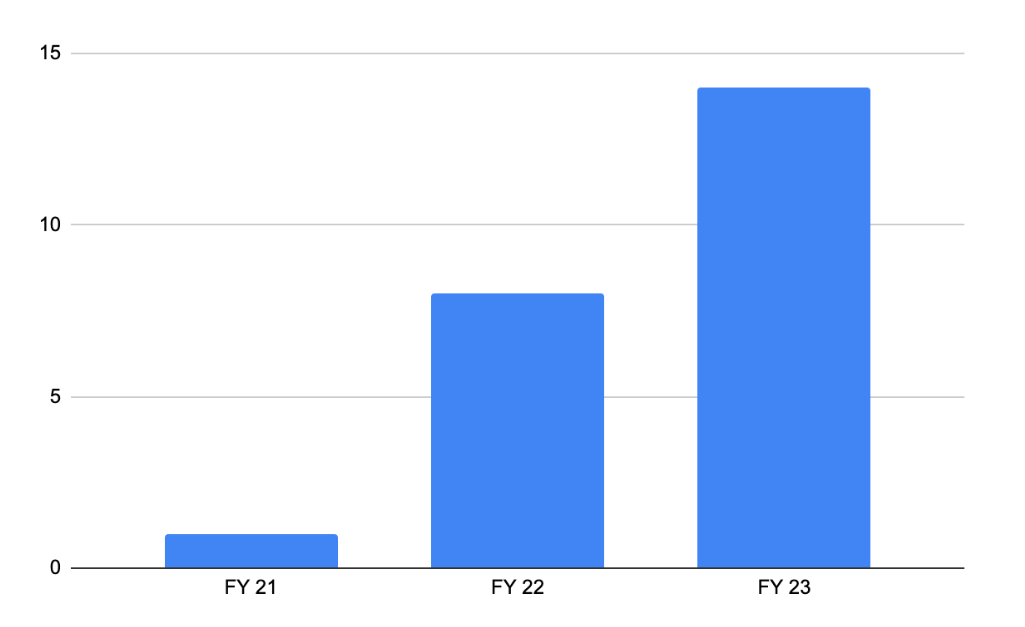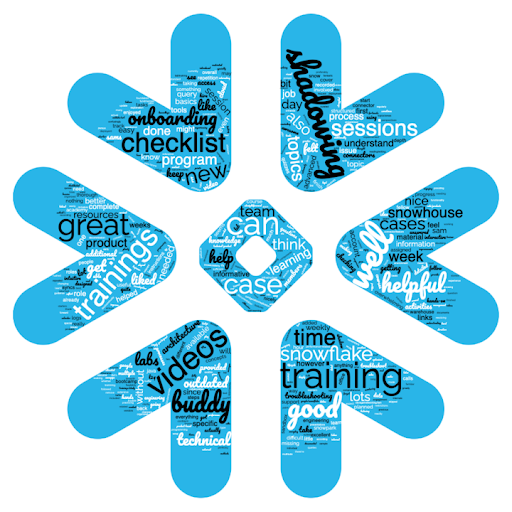We at Snowflake are on a never-ending quest to improve our customer experience. An often overlooked piece of that puzzle is the connection between employee experience and happy customers; nowhere is this more evident than in Snowflake’s support organization. High-growth companies aspiring to offer world-class support experiences would do well to prioritize a high-quality, scalable employee onboarding program —something companies may not see as having any relation.
Industry-wide, more business leaders are recognizing the link between employee satisfaction and that of customers, including Snowflake vendor Qualtrics, whose research directly links employee and customer experience outcomes. Competent and confident customer support employees are best prepared to solve customer problems, which improves customer satisfaction scores along with the employee experience. Snowflake’s support team has grown from fewer than 100 to nearly 400 people globally in just three years, so getting this right could make or break our customer experience.
How do we proactively understand and foster this employee-customer satisfaction connection? By recognizing the need for a more mature, scalable training process for new support employees. We implemented a new hire onboarding program that’s already seeing measurable, impactful results. In 2022, we saw 86% of new Cloud Support Engineers (CSEs) meet their performance criteria within the first full quarter following the completion of the onboarding program. That translates into timely, quality case interactions, higher customer satisfaction, and a positive impact on the whole team. Time to onboard CSEs reduced by 25%, from eight weeks to six weeks, with new hires ranking their overall satisfaction with the onboarding program an average of 4.6 out of 5 since the program launched.
Here’s a bit of what we’ve learned in pursuit of these encouraging results:
Start with the legacy perspective
If you want to develop an amazing employee experience, engage your current team as the key stakeholders they are. In our case, longtime support employees were critical to building a globally consistent support onboarding process that educated and empowered our new hires. We interviewed longtime team members to get feedback on their onboarding experience at Snowflake and even at previous companies. We asked them what worked and what didn’t, what they wished had been done differently, and what could have better prepared them for supporting our customers.
Getting new team members up to speed is a challenge in any support organization, but when your company, product, and customers are changing and growing at warp speed, tackling that challenge becomes even more imperative. Snowflake is a complex and ever-changing platform, so getting a solid foundation for providing customer support can take up to six months.
Starting with what we heard from Snowflake support veterans, and building on that with additional research, we fine-tuned our onboarding curriculum, building a foundation of core product knowledge and customer service best practices that drives consistent case quality. Because Snowflake’s product is evolving and improving with each release, and legal and compliance policies also change quickly, we built a framework to track those changes and ensure the most accurate information is reflected in what we’re teaching new hires.
Next, we developed custom training for specific Snowflake support roles. A good percentage of our support learning content is consistent across all functions, and then the experience branches into different journeys based on role; for example, a customer care representative will work through one path, while a CSE will work through another. This ensures that each new support starter is set up for success with targeted knowledge based on the job they’ll be doing day-to-day.
For CSEs, we support the pursuit of deeper technical knowledge earlier in their Snowflake journey, including SnowPro Core Certification during their onboarding period. As a result, we’re seeing that these CSEs are able to help their teammates and contribute to technical problem-solving more quickly. This is a win-win for customers and veteran support folks, while these new team members feel like they are contributing and making a difference quickly.

A “License to Queue”
Now known as License to Queue, the support team’s enhanced program reflects our efforts to build the world-class onboarding experience necessary to keep up with Snowflake’s rapid growth and robust platform. Key elements of the program include a mentor-like buddy who stays connected beyond the initial training period, delivery of instructor-led, in-person, and virtual training sessions, self-paced instruction, immediate availability of certification sources for third-party platforms such as Salesforce and public clouds, and ongoing surveys to continue listening and responding to new hires. We also survey buddies, so all stakeholders are heard throughout the process, and a veteran buddy recently described License to Queue as a “ wonderful, well-organized, and effective way to introduce new hires with Snowflake Support. Very helpful in building the required skill set and setting expectations on what is required.”
A team culture that gives new employees the time they need to get up to speed is a key element of this program’s ability to scale effectively. We foster a culture dedicated to “helping the new hire” throughout our organization; that help doesn’t just come from a new hire’s buddy, but is encouraged and expected from all members of the team. In fact, our interview process screens for team players right from the start! We also believe in giving new hires time to actually learn, understanding that people can only take in so much content in a short time, even when they’re anxious to start contributing. Realistically, any new employee will be drinking from the proverbial fire hose, but it’s important to find a balance and allow them time and opportunity to digest and assimilate so much new information.
Follow the sun
When we began the journey to improve Snowflake’s new hire onboarding, the process looked very different based on office and region. As with most companies in startup mode, we initially relied on support leads in each office to implement their own onboarding program and bring their new hires up to speed. Continuing this way was unsustainable and even as we were developing this program, several new Snowflake offices across Israel, Mexico, Japan, U.K., and more opened. This lack of centralized resources bred inconsistency. As our customer, if you got assigned to a representative in San Mateo, Calif., they might deal with your problem differently than if you were assigned to a care representative in Amsterdam, for example. But the downside for customers went beyond that—without enterprise-wide, federated processes for support troubleshooting and case resolution, Snowflake could not efficiently hand off cases across geographies.
Today we have a 24/7 “follow the sun” support organization. If a customer in the U.S. opens a case at 2 a.m. local time, it may be handled in India to start, and get transferred to the U.S. when local business hours resume. The aim is to make this process seamless for our customers at a scale of over 30,000 customer interactions per week. Every member of the support team has the same information and will troubleshoot and manage the case from one set of guidelines and best practices. At the same time, local and regional differences need to be acknowledged and honored, so we adapted the new global training to make sense to people across cultures and bridge any gaps.
An ongoing commitment
We are proud of the impact these new hire training enhancements have had so far, for both customers and employees. While we were pleased to see the new hire satisfaction score reach 4.6 (out of 5) at the end of January, these scores are still rising and escalations of customer cases have dropped to 2% of total cases as of January 31, 2023 (signaling that a customer’s first touchpoint is resolving the issue). We’re currently focused on developing additional advanced technical training opportunities, including hands-on labs and real-time experience with our engineering teams.

Today the entire industry is being buffered by uncertain economic headwinds. Such an environment can sometimes cause companies to pare back investments in their organizations and in their people. Thanks to the backing of Snowflake’s leadership team for building a world-class enterprise support organization, we can bring some continuity during turbulent times to our employees and customers alike. We urge anyone challenged to build organizations during this time to keep investing in their employee experience. Don’t lose the hearts and minds of your own in tough times; in fact, this may be the best time to build an employee experience that keeps people around.
Image credits: Designed by Jesse Ru



